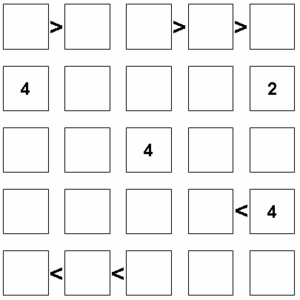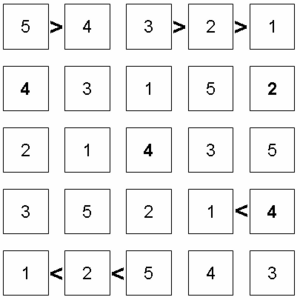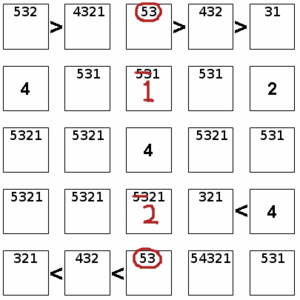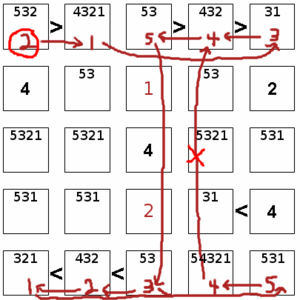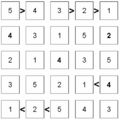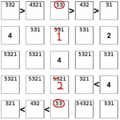Futoshiki facts for kids
Futoshiki (不等式, futōshiki), also known as More or Less, is a fun logic puzzle game that comes from Japan. Its name means "inequality", which gives you a big hint about how to play! You might also see it spelled hutosiki. This clever puzzle was created by Tamaki Seto in 2001.
The game is played on a square grid, usually 5x5, but it can be bigger. Your goal is to fill each square with a number. For a 5x5 grid, you'll use numbers from 1 to 5. The main rules are:
- Every row must have each number only once.
- Every column must have each number only once.
Some numbers might already be given to you at the start. The puzzle also has special "inequality" signs between some squares. These signs look like `>` (greater than) or `<` (less than). They tell you if a number in one square must be larger or smaller than its neighbor. You must follow these rules to solve the puzzle!
Contents
How to Solve a Futoshiki Puzzle
Solving a Futoshiki puzzle is like being a detective! You need to use different logic tricks to figure out where each number goes. The numbers already in rows and columns, along with the "greater than" or "less than" signs, help you narrow down the choices for each empty square.
Finding Possible Numbers
The first step is to look at each empty square and list all the numbers that could go there.
- Check the row: What numbers are already in this row? The empty square can't be those numbers.
- Check the column: What numbers are already in this column? The empty square can't be those numbers either.
- Check the inequality signs: If a square has a `>` sign pointing to it, its number must be bigger than the neighbor. If it has a `<` sign, it must be smaller. This helps you remove more possibilities.
Using "AB Elimination"
This is a smart trick! Imagine you have two squares in a row, and after checking, you realize they must contain only the numbers 1 or 2. If those two squares can only be 1 or 2, then no other square in that row can be 1 or 2. You can then remove 1 and 2 as possibilities for the other squares in that row. This helps you narrow down choices for the rest of the row.
Working with Inequalities
Sometimes, you can test a number in a square that has an inequality sign.
- Pick a possible number for a square.
- See what that number forces its neighbors to be because of the `>` or `<` signs.
- Keep following these forced numbers through the puzzle.
- If you reach a point where you can't place a number (like needing two of the same number in a row or column), then your first guess was wrong! You can then remove that number as a possibility for the starting square.
Let's look at an example. First, you list all possible numbers for each square based on the rules. Then, you might notice something special. For instance, in the middle column, the top and bottom squares might be the only places where 5 and 3 can go. If that's true, then you know 5 and 3 cannot go in the other squares in that column. This helps you remove 5 and 3 from the possibilities for the second and fourth squares in that column.
Here's another example of how logic helps. Imagine the top-left square.
- If you try putting a 2 there, the `>` sign means the next square must be 1.
- If the second square is 1, then the `>` sign after it means the third square must be 3 (if 2 is used).
- If you keep going, you might find that you end up needing to put two 4s in the same column, which is against the rules! This means 2 cannot be in the top-left corner.
The same thing happens if you try putting a 3 in the top-left corner. You'll also run into a problem. This kind of careful thinking helps you realize that only a 5 can go in the top-left corner. Once you know that, the rest of the puzzle often becomes much easier to solve!
A solved Futoshiki puzzle is a type of Latin square. Just like with Sudoku, harder Futoshiki puzzles need even more complex logic tricks to solve.
Images for kids


